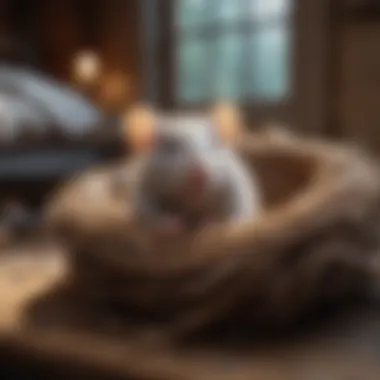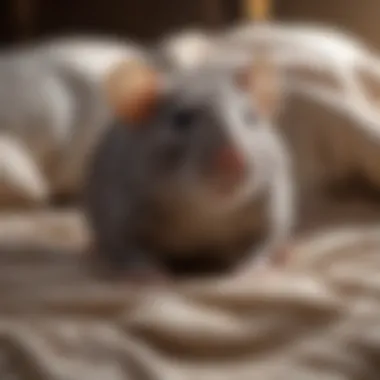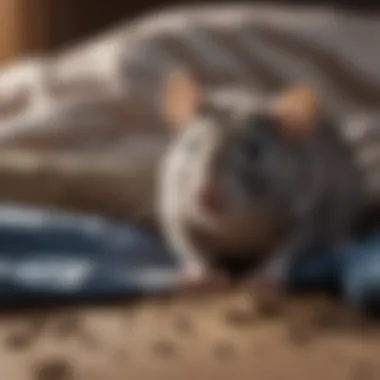Understanding Good Rat Bedding for Healthy Pets


Intro
Creating a suitable habitat for pet rats is crucial for their health and well-being. A significant element of this environment is bedding. With various materials available, understanding the advantages and disadvantages of each can be overwhelming. Before diving into specific beddings, it’s essential to understand a few fundamental aspects of rat behavior and needs.
Rats are social and intelligent animals that require a space where they feel safe. A comfortable and clean environment can enhance their quality of life, encourage natural behaviors, and reduce stress. Choosing the right bedding is not just about comfort; it directly impacts their hygiene and health. In this comprehensive guide, we will look closely at what makes good rat bedding, focusing on materials, cleanliness, safety, and more.
Understanding Your Pet
When considering the best bedding for rats, it is vital to first understand their behavior and requirements. This knowledge lays the foundation for a well-suited living environment.
Pet Behavior Basics
Rats are known for being curious and active. They often dig, burrow, and explore their surroundings. Their bedding should allow these behaviors while also providing warmth and a soft surface.
Common Breed Characteristics
Different rat breeds may have slightly differing needs. For instance, dumbo rats, known for their larger ears, might prefer bedding that mutes sound better since they can be more sensitive. Understanding these differences helps in selecting the most appropriate bedding material.
Species-Specific Needs
Rats are social creatures that thrive in a stimulating environment. Bedding is part of that environment. They require bedding that they can burrow into without endangering their health. It is also good to consider hypoallergenic options that minimize respiratory issues.
The Importance of Bedding Materials
Choosing the right bedding is essential. Each material has different properties that can benefit or harm the rats.
- Paper-based bedding: This is absorbent and dust-free, making it a safe option.
- Aspen shavings: Non-aromatic and less likely to irritate the respiratory system, aspen can be a good choice.
- Coconut fiber: This material is natural and allows good airflow but should be changed regularly to prevent mold.
Bedding significantly affects both the health and behavior of pet rats.
Hygiene Practices
Keeping the bedding clean is vital for preventing illness. Regular cleaning of the cage, along with frequent changes of bedding, helps maintain a hygienic environment. Ensure that waste is removed daily and bedding is replaced at least once a week.
Safety Considerations
Not all beddings are created equal. Some materials can cause respiratory issues or other health problems. Avoid using cedar or pine shavings, as these can emit toxic oils. Likewise, ensure that the bedding is free from dyes and chemicals, as these can be harmful to rats.
Finale
Good bedding is essential for pet rats. It affects their health, behavior, and overall comfort. Pet owners should carefully consider material choices, cleanliness, and safety to create an ideal living space. Understanding their pets' needs leads to informed decisions that help ensure happy and healthy rats.
Prologue to Rat Bedding
Creating a suitable environment for pet rats involves attention to various factors, with bedding being one of the most critical. Bedding serves multiple purposes, from providing a soft place for rats to sleep to helping maintain hygiene in their living space. Therefore, understanding the nuances of rat bedding is paramount for pet owners.
Understanding the Importance of Bedding
Bedding plays a vital role in ensuring the health and comfort of pet rats. Proper bedding allows for insulation, keeps the cage dry, and offers a natural material for rats to burrow in, which aligns with their instinctual behaviors. Furthermore, appropriate bedding can also mitigate unpleasant odors and absorb moisture. The right choice of bedding can significantly impact your pet's overall well-being.


Rats are more sensitive to their environment than many people realize. They require comfort and security to thrive. Beds that provide places to hide and explore create a sense of safety. In addition, good bedding absorbs urine and droppings, which helps in maintaining a hygienic living space. A dirty cage can lead to health problems, making regular bedding changes critical.
Common Myths About Rat Bedding
There are several misconceptions surrounding rat bedding that can hinder pet owners from making informed decisions. Some common myths include:
- All bedding is harmful: Not all bedding materials are toxic. While some types can be harmful, materials like paper-based products or aspen shavings are generally considered safe for rats.
- Bedding does not affect health: In reality, inadequate bedding can lead to respiratory issues or other health problems. Choosing the right type of bedding can contribute significantly to preventing illnesses.
- More bedding is always better: While it’s important to provide enough bedding for comfort, too much can make cleaning difficult and may trap waste materials.
- Rats do not care about bedding: This is false. Rats are known to engage with their surroundings. They value comfortable bedding for resting and nesting.
It is essential to educate oneself about the best practices in providing bedding for pet rats. Misunderstandings can lead to poor choices that might affect the animal’s physical and mental health.
Types of Rat Bedding Materials
Choosing the right bedding material for pet rats is vital. The bedding not only contributes to the comfort and overall well-being of these small mammals but also affects their behavior and health. Different types of bedding materials come with unique characteristics that can serve specific needs of your pet rats. Understanding these materials helps pet owners make informed choices that enhance their rats' living conditions.
Paper-Based Bedding
Characteristics
Paper-based bedding is made from recycled paper products. It is shredded or processed to create soft, absorbent materials. Its key characteristic is lightweight and the ease with which it can be changed. This type of bedding often comes in various textures, appealing to different preferences among pet owners. The softness can provide comfort for rats, making it a preferred option among many.
Benefits
One significant benefit of paper-based bedding is its absorbency. It can effectively manage moisture and odors, maintaining a fresher environment for your rats. Additionally, it is often dust-free, reducing the risk of respiratory issues in both rats and their owners. This makes it a popular choice for those looking to prioritize health and comfort in their rats’ habitats.
Drawbacks
However, paper-based bedding also has some drawbacks. It may not provide the same level of insulation as other materials. This can be important in colder climates. Furthermore, rats may chew on the bedding, leading to potential consumption of paper products, which could cause digestive issues.
Aspen Shavings
Characteristics
Aspen shavings are derived from the aspen tree, offering a natural option for rat bedding. Its key characteristic is its natural scent, which many find appealing. The shavings are thicker than paper, providing a different texture that some rats might enjoy. It is also biodegradable, making it an environmentally friendly choice.
Benefits
One of the notable benefits of aspen shavings is their absorbent quality. They effectively control moisture, helping to keep the habitat clean. Additionally, aspen is low in phenols, which are chemicals harmful to rats and other small animals. This makes it safer for use as bedding compared to aromatic wood shavings like cedar or pine, which can be toxic.
Drawbacks
Despite these benefits, aspen shavings have some limitations. The larger shavings may be uncomfortable for some rats, especially those that prefer softer bedding. Also, aspen shavings can become quite dusty, which may aggravate allergies for sensitive owners or pets.
Cotton Bedding
Characteristics
Cotton bedding is soft and fluffy, often found in environmentally friendly packaging. Its key characteristic is the plushness that offers a cozy place for rats. Unlike other materials, cotton is usually free of chemicals that could pose risks to the pets.
Benefits


The benefits of cotton bedding include excellent insulation properties and comfort. It can keep rats warm, which is essential, especially in colder climates. Additionally, cotton is often machine washable, making it easy for owners to maintain cleanliness in their pets' habitats.
Drawbacks
The primary drawback of cotton is that it can store moisture, which may lead to odor if not cleaned regularly. Additionally, there is a risk of ingestion. Rats may chew and consume cotton fibers, leading to potential digestive concerns.
Hemp Bedding
Characteristics
Hemp bedding is made from the fibers of the hemp plant. It presents a unique characteristic with its high absorbency and minimal dust. The natural fibers create a soft, comfortable base for rats. Hemp is also biodegradable, making it a useful choice for environmentally conscious pet owners.
Benefits
Among the advantages, hemp bedding offers superior absorbency. It helps in controlling odors effectively, allowing for a fresher cage environment. Furthermore, it tends to be low in allergens, making it suitable for sensitive pets and owners. Hemp bedding also provides good insulation, which can keep rats warm.
Drawbacks
However, some rat owners may find hemp bedding more expensive compared to other options. Additionally, the availability can vary based on location, making it harder to source for some pet owners.
Coco Fiber Bedding
Characteristics
Coco fiber bedding is made from the fibrous husk of coconuts. Its characteristic is its rough texture and natural look. This type of bedding is often compressed and expands when it is unpacked. This unique aspect makes it distinct from other bedding materials.
Benefits
The benefits of coco fiber bedding include its excellent drainage properties. It can absorb moisture while keeping the surface relatively dry. This feature helps in controlling odors and maintaining a cleaner environment. Furthermore, coco fiber is eco-friendly and biodegradable, appealing to environmentally conscious pet owners.
Drawbacks
On the downside, coco fiber can be more abrasive than other bedding materials. This roughness might not be comfortable for all rats, especially older or softer-bellied ones. Additionally, coco fibers can become heavy when wet, making vertical spacious clean-up more challenging.
Evaluating Bedding Safety
When selecting bedding for your pet rats, safety must remain a paramount consideration. Bedding plays a critical role in the overall environment of your pets, affecting their health and wellbeing. By evaluating materials and their potential hazards, you ensure a nurturing habitat conducive to their natural behavior and comfort. The choices you make about bedding can impact not only the physical space your rats inhabit but also their emotional state and activity levels.
Toxicity Concerns in Bedding Materials
Not all bedding materials are created equal. Some may contain harmful substances that can critically affect your pet rats. Common toxic elements to be aware of include certain types of wood shavings, such as cedar and pine, which can release harmful phenols. These chemicals may lead to respiratory problems or even liver damage in rats. Moreover, when bedding is treated with chemicals or dyes, it can pose an additional threat.
Here is a breakdown of what to avoid:
- Cedar Shavings: Often used due to their aromatic properties, these shavings can lead to respiratory irritation.
- Pine Shavings: Similarly harmful, pine can release volatile compounds that irritate the lungs.
- Synthetic Materials: Bedding containing plastics or treated fabrics can often be toxic, leading to ingestion issues or skin irritations.
Before choosing a bedding option, always read product labels and conduct thorough research regarding toxicity. Consider opting for natural and untreated alternatives to minimize any risks to your rats' health.
Dust and Allergies


Dust is another significant factor in bedding safety. Many bedding materials generate dust when disturbed, which is particularly problematic for small animals like rats, who have sensitive respiratory systems. The inhalation of dust can cause various respiratory complications. Symptoms may include sneezing, coughing, or other signs of distress.
To mitigate these risks, consider the following steps:
- Choose Low-Dust Options: Bedding types such as paper-based or hemp materials typically produce less dust compared to traditional wood shavings.
- Regular Cleaning: Frequent cleaning of the bedding can help reduce dust accumulation. Vacuum or brush the area regularly.
- Air Quality: Maintain a well-ventilated space that allows for air circulation. This practice will help minimize irritants in the environment.
Maintaining Cleanliness in Your Rat's Bedding
Maintaining cleanliness in your rat’s bedding is essential for the overall health and well-being of your pets. A clean environment reduces the risk of diseases and ensures that your rats feel comfortable in their habitat. Rats are naturally curious creatures, and they spend a significant amount of time in their bedding. Therefore, keeping their living space clean is not just a task but a necessary part of responsible pet ownership.
Regular cleaning of bedding prevents the buildup of waste, which can lead to unpleasant odors and attract pests. It also contributes to minimizing allergens, enhancing air quality in the enclosure, and promoting a happier disposition among your rats. A clean habitat can foster exploration behaviors, allowing rats to thrive and express their natural instincts.
Cleaning Routine
A cleaning routine should be established to maintain optimal hygiene in your rat's bedding. This routine can vary depending on the number of rats and the type of bedding used. Here is a suggested routine that can be easily adapted:
- Daily Spot Cleaning: Remove any soiled bedding or waste daily. This can be as simple as using a small scoop or a dustpan to clear out droppings and urine spots. Freshen up the bedding by adding new material as needed.
- Weekly Deep Cleaning: Once a week, perform a thorough cleaning. Take out all bedding and wash the enclosure with a safe non-toxic cleaner. Rinse well to remove all cleaning agents. Allow the enclosure to dry before replacing the bedding.
- Monthly Changes: Consider changing all bedding material thoroughly every 4 weeks. This allows for the complete removal of old bedding, which may harbor odors or potential allergens. Provide fresh bedding to ensure a clean start.
"Regular maintenance of your rat's bedding is key to preventing health issues and ensuring their happiness."
Indicators for Replacement
Recognizing the signs that it is time to replace your rat's bedding is crucial in maintaining a healthy habitat. Here are some indicators:
- Odor: If you notice persistent unpleasant smells, it is a strong sign that the bedding needs changing. Fresh bedding should not have a strong odor.
- Discoloration: If the bedding has become dark and damp from urine, it is time for replacement.
- Pest Sightings: Any signs of insects or pests indicate a serious need for thorough cleaning and complete replacement of bedding material.
- Wear and Tear: If bedding materials are breaking down or losing their structure, they are less effective in providing comfort and cleanliness.
By maintaining cleanliness and being attentive to these indicators, pet owners can significantly enhance the quality of their rats' living conditions.
Impact of Bedding on Rat Behavior
The choice of bedding plays a significant role in the overall well-being of pet rats. Understanding how bedding affects their behavior can lead to a more enriching and enjoyable environment for both the rats and their owners. Good bedding influences comfort and can enhance natural behaviors associated with exploration and nesting.
Exploration and Comfort
Rats are naturally curious creatures. They engage in exploratory behavior when they feel safe and comfortable in their surroundings. The type of bedding selected can greatly influence this aspect of their personality. For instance, soft and absorbent materials allow rats to burrow and nest, mimicking their instinctual behaviors in the wild. Bedding such as paper-based materials or hemp provides a comforting texture that invites exploration. This exploration is not just for fun; it contributes to their mental stimulation. A well-constructed bedding environment encourages rats to investigate, which can reduce stress and anxiety.
The smell of the bedding can also impact their comfort. For example, cedar shavings may produce a strong odor that some rats find overwhelming. In contrast, aspen shavings have a milder smell and are generally well-accepted by rats, fostering a sense of security. This balance of comfort and olfactory friendliness is vital for maintaining positive behavioral tendencies.
Nesting Behavior
Nesting is a critical behavior for rats, serving both as safety from predators and a method of personal comfort. High-quality bedding allows rats to create cozy nests that foster a sense of security. Materials like cotton and hemp are particularly suited for this purpose, as they can hold shape and provide insulation.
It is essential for pet owners to recognize that the nesting instinct is not merely a whimsical behavior. It is a necessary part of a rat's life. When they do not have adequate nesting material, they may exhibit signs of stress or boredom, which can lead to undesirable behaviors such as chewing on cage bars or excessive vocalization.
To encourage natural nesting behavior, consider providing your rats with a variety of bedding options. Offering both soft and shredable materials can appeal to their instincts. This way, rats can choose what best suits their needs at any moment.
End
The conclusion of this guide is critical for pet owners seeking to provide the best living environment for their rats. Proper bedding is not just a luxury; it plays a significant role in promoting the health and happiness of these small creatures. Selecting appropriate bedding can minimize health risks, enhance comfort, and influence their natural behaviors.
Final Thoughts on Choosing Rat Bedding
In choosing the right bedding, several key elements should be considered:
- Material Safety: Ensure that the bedding material is non-toxic and free from harmful chemicals. Materials like paper-based bedding and aspen shavings are often recommended for their safety.
- Comfort and Warmth: Rats need a cozy environment to thrive. Soft and absorbent bedding can help regulate their temperature and provide comfort.
- Ease of Cleaning: Regular maintenance is essential to avoid odors and health issues. Choose bedding that simplifies the cleaning process.
- Behavioral Enrichment: Consider how bedding affects your rats’ natural behaviors. Materials that allow for nesting and burrowing can enrich their living space.
Ultimately, it’s about creating a safe and enriching habitat that meets the needs of your rats. The consequences of neglecting bedding choice can lead to stress, health problems, and an uncomfortable living environment. Make informed decisions and regularly re-evaluate your choice of bedding as necessary.







